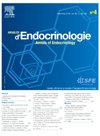Severe cutaneous adverse reactions to allopurinol in the elderly: A case series
IF 2.9
3区 医学
Q3 ENDOCRINOLOGY & METABOLISM
引用次数: 0
Abstract
Introduction
Severe cutaneous adverse drug reactions (SCARs) are serious and potentially life-threatening skin reactions associated with medications used for preventive or therapeutic purposes. This study aims to describe the epidemiological, clinical, evolutionary, and prognostic characteristics of severe allopurinol-induced eruption in the geriatric population.
Materials and methods
We conducted a retrospective study including all patients aged 65 years or older between 2005 and 2025 who presented with SCARs and confirmed allopurinol causality based on pharmacovigilance investigations. Among 42 patients with SCARs, 20 cases induced by allopurinol were included.
Results and discussion
The mean age was 73.3 years, with a male-to-female ratio of 0.11. The primary indications for allopurinol were gout (55%) and hyperuricemia (15%). The drug-induced skin reaction cases included DRESS syndrome (80%), toxic epidermal necrolysis (10%), and Stevens-Johnson syndrome (10%). The average time to onset was 20 days. The predominant clinical presentation was generalized maculopapular exanthema. Fever and mucosal involvement were observed in 60 and 40% of cases, respectively. Hyper eosinophilia was noted in 15 patients. Management involved discontinuation of allopurinol and initiation of symptomatic treatment. The outcome was mostly favorable, although two deaths were reported.
Conclusion
Allopurinol is one of the most frequently implicated drugs in SCARs, with a higher prevalence in the elderly due to its widespread use in this population. DRESS syndrome is the most common reaction. Although the prognosis is relatively good, it is crucial to avoid allopurinol use in asymptomatic hyperuricemia and to enhance clinical vigilance to prevent these potentially fatal complications. This study highlights the importance of careful drug monitoring and the need for alternative therapeutic strategies in the geriatric population to minimize the risk of severe adverse reactions.
老年人对别嘌呤醇的严重皮肤不良反应:一个病例系列
严重皮肤药物不良反应(scar)是指与用于预防或治疗目的的药物相关的严重且可能危及生命的皮肤反应。本研究旨在描述老年人群中严重别嘌呤醇引起的皮疹的流行病学、临床、进化和预后特征。材料和方法我们进行了一项回顾性研究,纳入了2005年至2025年期间所有65岁及以上出现疤痕的患者,并根据药物警戒调查证实了别嘌呤醇的因果关系。42例瘢痕形成患者中,20例为别嘌呤醇所致。结果与讨论平均年龄73.3岁,男女比0.11。别嘌呤醇的主要适应症是痛风(55%)和高尿酸血症(15%)。药物性皮肤反应病例包括DRESS综合征(80%)、中毒性表皮坏死松解症(10%)和Stevens-Johnson综合征(10%)。平均发病时间为20天。主要临床表现为广泛性黄斑丘疹。60%和40%的病例分别出现发热和黏膜受累。15例患者嗜酸性粒细胞增多。处理包括停止别嘌呤醇和开始对症治疗。结果基本上是有利的,尽管据报道有两人死亡。结论别嘌呤醇是scar中最常见的相关药物之一,由于其在老年人中的广泛使用,其在老年人中的患病率更高。DRESS综合征是最常见的反应。虽然预后相对较好,但在无症状高尿酸血症中避免别嘌呤醇的使用和提高临床警惕以预防这些潜在的致命并发症是至关重要的。这项研究强调了仔细的药物监测的重要性,以及在老年人群中寻找替代治疗策略的必要性,以尽量减少严重不良反应的风险。
本文章由计算机程序翻译,如有差异,请以英文原文为准。
求助全文
约1分钟内获得全文
求助全文
来源期刊

Annales d'endocrinologie
医学-内分泌学与代谢
CiteScore
4.40
自引率
6.50%
发文量
311
审稿时长
50 days
期刊介绍:
The Annales d''Endocrinologie, mouthpiece of the French Society of Endocrinology (SFE), publishes reviews, articles and case reports coming from clinical, therapeutic and fundamental research in endocrinology and metabolic diseases. Every year, it carries a position paper by a work-group of French-language endocrinologists, on an endocrine pathology chosen by the Society''s Scientific Committee. The journal is also the organ of the Society''s annual Congress, publishing a summary of the symposia, presentations and posters. "Les Must de l''Endocrinologie" is a special booklet brought out for the Congress, with summary articles that are always very well received. And finally, we publish the high-level instructional courses delivered during the Henri-Pierre Klotz International Endocrinology Days. The Annales is a window on the world, keeping alert clinicians up to date on what is going on in diagnosis and treatment in all the areas of our specialty.
 求助内容:
求助内容: 应助结果提醒方式:
应助结果提醒方式:


